Excerpts from Jim Conrad's
Naturalist Newsletter
from the February 22, 2015 Newsletter issued from Río Lagartos, on the Yucatan Peninsula's northern coast (~N21.60°, ~W88.16°), Yucatán state, MÉXICO
MUDFLAT POLYCHAETES
A couple of years ago in Texas, beneath the microscope's lenses, we found a tiny worm living in a drop of water from the Dry Frio River behind the cabin, still shown at www.backyardnature.net/n/13/130303wm.jpg.
The worm turned out to be an annelid, or segmented worm, like the common earthworm, but it was a special class of annelid, one known as a polychaete, or "bristle worm." I'd been surprised to find such a tiny, free-living polychaete because my impression of what a polychaete was had been based on the one we'd found previously on the Yucatan's Caribbean coast, inhabiting carbonate tubes plastered onto the inner walls of seashells, as shown at www.backyardnature.net/n/11/110911wt.jpg.
That was the beginning of my understanding that polychaetes are a varied lot. In fact, here we've already found other polychaete species with different manners of living -- one living in tubes composed of cemented white sand, and another in calcareous tubes looking like tiny white snail shells attached sideways on Shoalgrass leaves. In our recent February 15th Newsletter, we saw how Lugworms, also a kind of polychaete, excrete sizable coiled sand "castings" onto the beach. You can review these various polychaete species on our Worm Index Page at www.backyardnature.net/n/worms.htm.
This week when Rayo and I went onto the usually flooded mudflats in front of Río Lagartos, it was like taking a university course in polychaete diversity. We'd gone there to find something Rayo had seen but couldn't figure out. He'd described it as like a long weed root that was hollow inside and outside was covered with small seashells and shell fragments. As our boat approached the mudflat where the mystery item had been spotted, we saw what's shown below:

With slender Black Mangrove pneumatophores pointing skyward in the background, the mudflat was populated with piles of mud exactly like the Lugworm castings profiled in our February 15th Newsletter -- where our Lugworms were identified as Arenicola brasiliensis. But unlike with our earlier discovery, here were acres of them. A close-up of one of these mudflat castings is shown below:
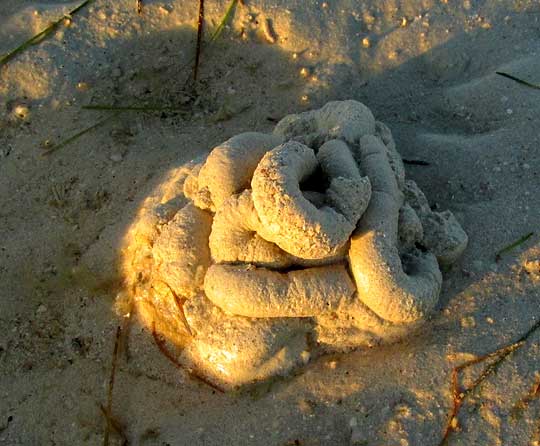
Quickly Rayo found one of his mystery items looking like a weed taproot, poking from the mud. It's shown below:
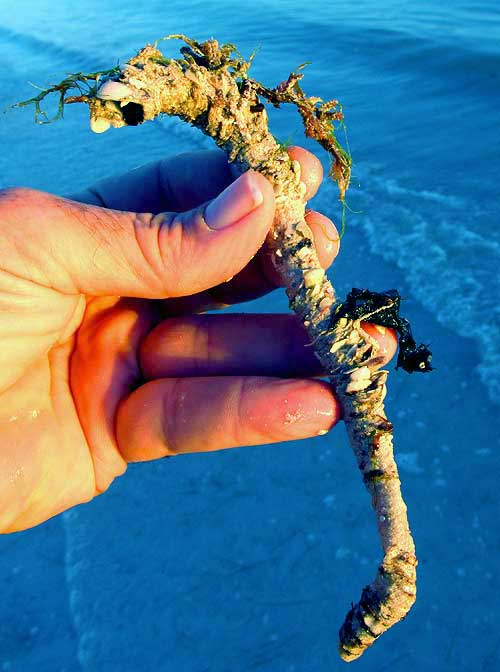
Shells and shell fragments were indeed stuck to it, as shown below:
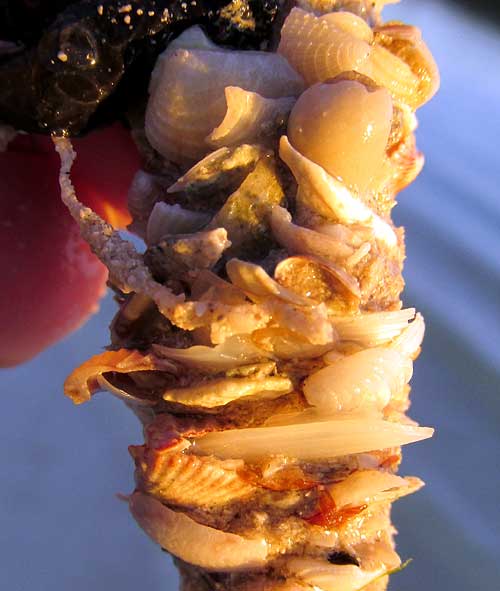
And inside it was indeed hollow, as shown below:

Something wormlike had occupied this tube. Remembering that polychaetes often encrust their tube exteriors with shells and shell fragments, it was easy to decide that probably this was a polychaete tube. Earlier when we'd dug several inches around our Lugworm burrow, there'd been no such shell-encrusted casing, so this seemed to have been made by yet a different polychaete species.
This wasn't the end of our polychaete lessons, though. In shallow water at the mudflat's edge many holes were issuing flaccid balloons of gelatinous material that swung back and forth with the advance and retreat of each wave, as shown below:

In my hand the gelatinous blobs looked like what's shown below:
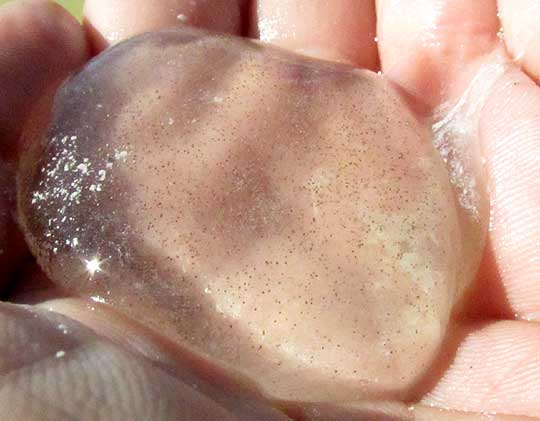
Inside each blob were suspended thousands of tiny specks, presumably eggs -- and from what I could determine on the Internet later they were polychaete eggs -- shown closer up below:

Up on the mud from which water had receded, an extraordinarily long egg mass stretched from its hole past Rayo's colorfully tattooed legs, shown below:
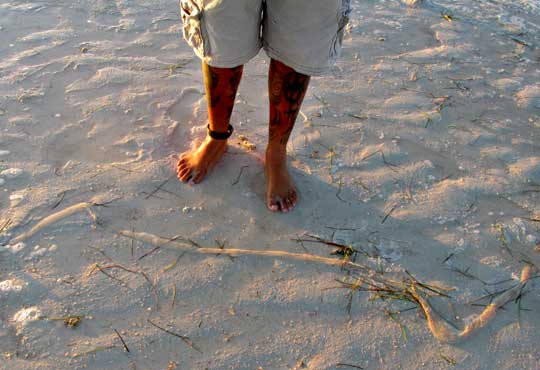
Realizing what these gelatinous egg masses were, and remembering that through clear water we've always seen them on the estuary floor below the boat -- and wondered what they were -- it became clear that polychaete influence doesn't end at the low water mark. This mudflat and the whole estuary -- especially when you remember those tiny ones in white, snail-like tubes speckling all Shoalgrass leaves -- is a polychaete urban zone, a niche of Nature where polychaetes are a dominant life form.
Polychaetes fossils are known from the early Cambrian Period, over 500 million years ago, from a time when the Earth's land masses still bore no life, for all living things occupied the seas. Taxonomically, the Class Polychaeta comprises about 10,000 species worldwide. María Ana Tovar-Hernández et al writing in the online Mexican Government "Revista mexicana de biodiversidad," in 2014, says that in Mexico we have about 1500 polychaete species in 63 families and 460 genera. Though our Texas polychaete was a freshwater species, polychaetes mostly are marine. With 1500 Mexican species, most of them marine, no wonder we're finding such a diversity of polychaetes here along the coast.
Polychaetes with their extensive burrowing aerate the soil and "plow" it, keeping the soil from compacting. Their "maintenance" of the soil enables other species to colonize, thus adding diversity and stability to the greater ecosystem. Earth-burrowing polychaetes do for submerged and water-saturated soil what earthworms do for dry land ecology. And remember that Charles Darwin wrote of earthworms that "...it may be doubted if there are any other animals which have played such an important part in the history of the world as these lowly organized creatures."